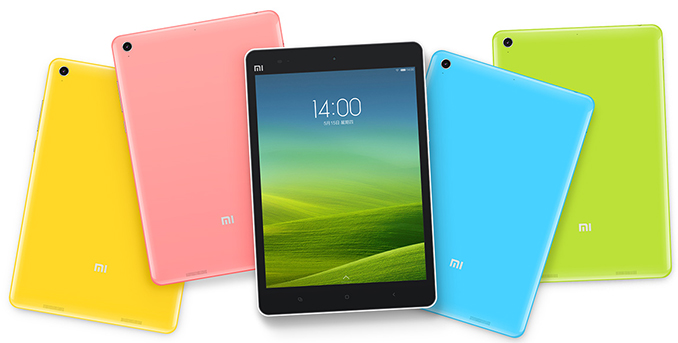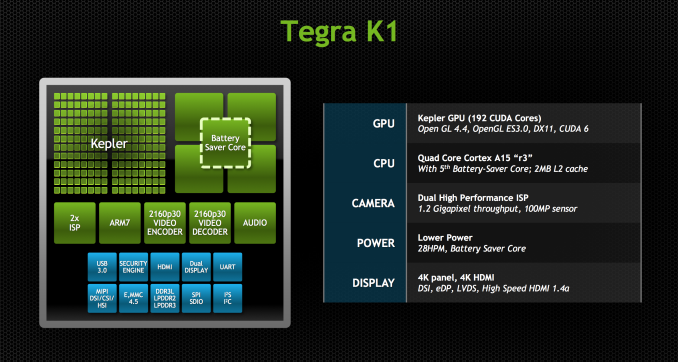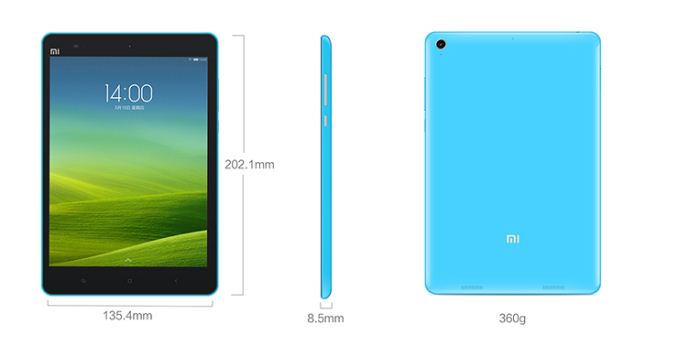Xiaomi Announces the MiPad: The First Tegra K1 Device
by Brandon Chester on May 15, 2014 9:40 AM EST
Today Xiaomi introduced its first tablet: the MiPad. The tablet bears similarity to both Apple’s iPad Mini and iPhone 5c. On the front of the tablet we have a 7.9” 2048x1536 IPS display (sourced from both Sharp and AUO Optronics) which is surrounded by an asymmetrical bezel. On the back we have a plastic shell of multiple different colors which Xiaomi itself states is made with the same injection molding technology as the iPhone 5c. There is also an 8MP Sony camera on the back with an F/2.0 aperture, and a 5MP camera on the front. The most interesting part of the Mi Pad is not on the outside, it's on the inside. The MiPad is the first consumer device to be announced that is powered by NVIDIA's Tegra K1 SoC.
As you may recall, NVIDIA introduced Tegra K1 to the world at CES 2014. It marks a huge departure from NVIDIA's mobile graphics strategy, abandoning the old Tegra GPU roadmap in favor of its desktop Kepler architecture.
Tegra K1 has two flavors, both built on a 28nm HPm process. One uses NVIDIA's Project Denver which will include two custom ARMv8 cores designed by NVIDIA. Denver is not slated to ship until later this year and so what we see in the MiPad is the other flavor of Tegra K1 which is a quad core ARM Cortex A15 design. Similar to other recent Tegra SoCs, this version of the K1 features four Cortex A15s plus an additional companion Cortex A15 optimized for lower frequencies for periods of low CPU usage. The CPU cores are based on a newer revision of Cortex A15 (r3p3) which includes finer grain power gating to reduce power consumption compared to revision r2p1 in the Tegra 4. This increase in efficiency will help balance out NVIDIA's move from a 1.9GHz max clock speed on Tegra 4 to over 2GHz on Tegra K1 (the move to 28nm HPm should help as well). The Tegra K1 SoC in the MiPad will ship with a max clock speed of 2.2GHz and 2GB of LPDDR3 RAM.
The GPU on Tegra K1 is something completely different from previous Tegra designs. Previous Tegra chips integrated NVIDIA's GeForce ULP core designed exclusively for its mobile platforms. With Tegra K1 Nvidia abandoned the idea of having a separate mobile roadmap for GPU designs and has merged its mobile and PC GPU roadmaps. The result is that Tegra K1 and all subsequent designs will ship with GPUs using the same architecture as NVIDIA's PC parts. With Tegra K1 we get a complete implementation of NVIDIA's Kepler architecture with 192 CUDA cores, 4 ROPs, and 8 texture units. It also brings along OpenGL ES 3.0, OpenGL 4.4, DirectX 11, CUDA 6.0, and every other API that Kepler supports.
NVIDIA has also shown a commitment to releasing software that will take advantage of their mobile GPUs. The company recently worked with Valve to bring Half Life 2 and Portal over to the NVIDIA Shield which is powered by a Tegra 4 CPU and I am sure that crafty users will bring the apps over to Tegra K1 devices if NVIDIA does not do so itself.
Beyond the SoC, the other internal specs for the MiPad include a 25.46 Whr (6700mAh) battery, 16 or 64GB of internal NAND, and a MicroSD slot. Connectivity includes support for 802.11 b/g/n/ac and Bluetooth 4.0. As with other Xiaomi devices, the MiPad runs Android with the MIUI UI atop it. It will launch in China sometime in June priced at 1499 yuan ($240) for the 16GB model and 1699 yuan ($272) for the 64GB model.












82 Comments
View All Comments
andrewwilliams1985 - Thursday, May 15, 2014 - link
I dont want this http://bit.ly/1myG31gPenti - Thursday, May 15, 2014 - link
Nice to see them expand their business, while I'm a bit critical on their MIUI-forklike Android OS it sells hugely in China, there they have to have a fork basically but they do seem to lag a bit on the version but does great in China and the last quarter they were one of the top ten smartphone makers in the world. Spec wise it seems fine, OGLES 3.0 means it's kinda future proof, don't know how good the Nvidia BSP/Android support really is yet though. Styling reminds me of the Asus MeMO Pad, but mostly because they also sold pink ones :). Looks like they source the 7.9 "retina" screen Apple uses here. They even call it so. They might as well just have went with something else there. Don't get why they use physical/capacitive buttons on this form factor either.errorr - Thursday, May 15, 2014 - link
What I'm curious about is battery life. Every other gpu architecture does some form of tile based deferred rendering vs. immediate mode rendering of a Kepler. (Technically Adreno can do immediate when asked or a heuristic switches modes dynamically).While TBDR has some drawbacks it is waaaaay more efficient in terms of memory reads and writes as well as fully utilizing all the architecture at once. (The deferred part means that the GPU waits until an entire scene is ready before it renders so it can optimize resource scheduling which also reduces power. Also makes certain types of AA virtually free)
The problem that Tegra could have is that all that extra bandwidth uses a lot of power. That may not be as big of a deal on desktop where power constraints are tiny and bandwidth is cheap. But on a mobile platform you are gonna use a lot more power no matter what.
One solution would be to have a huuuuge cache with some really good caching algorithm like what the Apple A7 does to reduce reads from RAM but that doesn't seem economically feasible for Tegra.
So is Kepler really power efficient to counteract its architecture disadvantages? Kepler was designed without the absolute need to minimize those pesky memory reads and writes.
Also it may depend on the app quality as I know a lot of people are unaware of good coding practices for mobile archs and I remember ARM complaining about how unrealistic benchmarks meant to stress mobile GPUs are.
Will be interested but I have serious doubt's about the power efficiency of Kepler even if it is more powerful overall.
ams23 - Thursday, May 15, 2014 - link
The Kepler.M GPU in Tegra K1 is ~ 1.5x more power efficient than the best ultra mobile GPU's available today, on the same fab process node to boot: http://cdn.pcper.com/files/imagecache/article_max_... . According to the Tegra K1 whitepaper, this GPU has many features to help improve power efficiency including: hierarchical on-chip Z-cull, primitive culling, early Z culling, Texture/Z/color compression, and a relatively large unified L2 cache. And on a side note, Adreno GPU's are not tile based deferred renderers.fivefeet8 - Friday, May 16, 2014 - link
Battery life of the device is not as power hungry as you seem to think.jasonkcarter - Thursday, May 15, 2014 - link
I bet Apple's already got their lawyers primed if this thing becomes successful. This thing is a lawsuit waiting to happen. Seriously, they couldn't think of a name for the thing that didn't end in "iPad"?skypacer - Friday, May 16, 2014 - link
Seriously, the "MiPad" have no offical name in English yet, its name in Chinese is Xiaomi Pad, which is pretty natural, for its a Pad provided by Xiaomi.com.BTW, xiaomi means millet in Chinese.
TheJian - Wednesday, May 21, 2014 - link
http://arstechnica.com/gaming/2014/03/opengl-es-3-...It's a kepler, it should support OpenGL ES3.1 without issue. They need to update their spec sheet.
"While some mobile GPUs, such as NVIDIA's Tegra K1, will support 3.1 with nothing more than driver updates, other GPU families might need new chips."
I don't believe there is anything in ES3.1 that isn't already in OpenGL4.4 which is already supported here in K1. ES comes from it's bigger brother. ES3.0 took from OpenGL 3.1, and it seems ES 3.1 probably takes from OpenGL 4.4.
http://www.weand.com/news/2014-04-22/Nvidia_second...
You can translate that from chinese to english at google etc. They say:
"Earlier this CES 2014 Conference , Nvidia released the latest generation of its own processor Tegra K1, includes 32 - and 64- bit versions , both versions of the GPU parts are built 192 Kepler CUDA cores, and chips for the first time in the history of the mobile space supports OpenGL ES3.1 standard."
That was last month.
Brakken - Friday, May 30, 2014 - link
Xiaomi is great! I love how honest they are with their total lack of creativity and theft. They even do blue T-shirts and Apple fonts and effect in their very own keynotes. SO innovative!wunaru - Tuesday, July 8, 2014 - link
339.99w u n a . r u